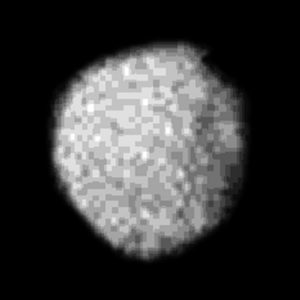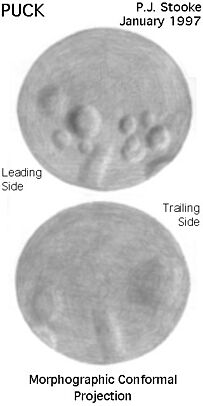Puck (moon) facts for kids

Puck as imaged by Voyager 2 on January 1986. The image is centered on Puck's south pole. Despite the low resolution, several craters have been identified, including Bogle on the upper right
|
|
| Discovery | |
|---|---|
| Discovered by | Stephen P. Synnott / Voyager 2 |
| Discovery date | December 30, 1985 |
| Designations | |
| MPC designation | Uranus XV |
| Pronunciation | /ˈpʌk/ |
| Adjectives | Puckian |
| Orbital characteristics | |
| 86004.444±0.064 km | |
| Eccentricity | 0.00012±0.000061 |
| 0.76183287±0.000000014 d | |
|
Average orbital speed
|
8.21 km/s |
| Inclination | 0.31921°±0.021° (to Uranus's equator) |
| Satellite of | Uranus |
| Physical characteristics | |
| Dimensions | 162 × 162 × 162 km |
|
Mean radius
|
81±2 km |
| 82000 km2 | |
| Volume | 2226100±7.8% km3 |
| Mass | (1.91±0.64)×1018 kg |
|
Mean density
|
~0.858 g/cm3 |
| ~0.019 m/s2 | |
| ~0.056 km/s | |
| synchronous | |
| zero | |
| Albedo |
|
| Temperature | ~65 K |
| 20.5 | |
Puck is the sixth-largest moon orbiting the planet Uranus. The Voyager 2 spacecraft discovered it in December 1985. Its name, Puck, comes from a character in Shakespeare's plays. This is a common way to name moons of Uranus.
Puck's path around Uranus is between the planet's rings and its first large moon, Miranda. Puck is shaped almost like a ball, with a diameter of about 162 kilometers (100 miles). Its surface is dark and covered with many craters. Scientists have also found signs of water ice on its surface.
How Puck Was Found and Named
Puck is the biggest of Uranus's inner moons. It was found using pictures taken by the Voyager 2 spacecraft. This happened on December 30, 1985. At first, it was given a temporary name: S/1985 U 1.
The moon was later named after a character called Puck. This character is a playful sprite from Shakespeare's play A Midsummer Night's Dream. In old stories from Celtic and English traditions, a Puck is a mischievous spirit. The moon is also known as Uranus XV.
What Puck Is Like
Puck is the largest inner moon of Uranus. It orbits closer to Uranus than the moon Miranda. Puck is bigger than Portia but smaller than Miranda, which is the smallest of Uranus's five main moons. Puck's path is located between Uranus's rings and Miranda.
We don't know much about Puck, but we do know its radius is about 81 kilometers (50 miles). Its surface reflects about 11% of the sunlight that hits it. This is called its albedo.
Voyager 2 was able to take detailed pictures of Puck. These pictures showed that Puck is shaped like a slightly stretched ball, not a perfect sphere. Its surface is very dark and covered with many craters. Scientists have named three craters on Puck. The biggest one is about 45 kilometers (28 miles) wide. Studies using the Hubble Space Telescope have also found signs of water ice on Puck.
Scientists think Puck is likely made of a mix of water ice and other materials. It might be a "rubble pile" moon. This means it could have been broken apart by a crash and then came back together. Its surface is covered with a dark material, similar to what is found in Uranus's main rings. This dark material might be rocks or changed organic stuff. The lack of bright rays around its craters suggests that Puck's materials have not separated into different layers, like a core and mantle.
Named Craters on Puck
Puck has three craters that have been given names. These names come from mischievous spirits in different folklores.
| Crater | Coordinates | Diameter (km) | Approval date | Named after | Ref |
|---|---|---|---|---|---|
| Bogle | — | ~47 km | 1988 | Bogle (Celtic) | WGPSN |
| Butz | — | — | 1988 | Butz (German) | WGPSN |
| Lob | — | — | 1988 | Lob (English) | WGPSN |
See also
 In Spanish: Puck (satélite) para niños
In Spanish: Puck (satélite) para niños



